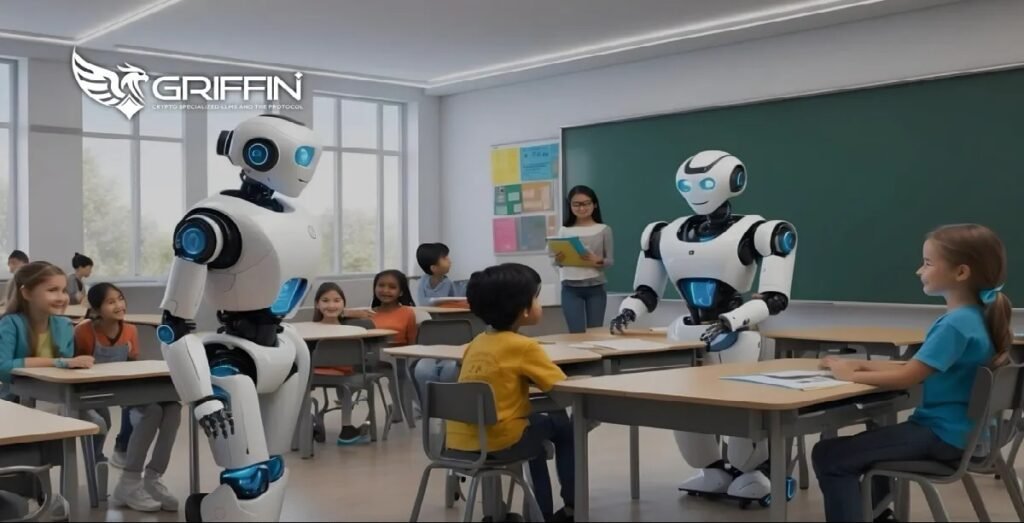
AI in Education: Unlocking New Possibilities
Imagine a classroom where learning fits each student’s needs. Technology makes education a personal journey of discovery. AI in education is more than just a trend—it’s changing how we teach and learn.
AI-powered educational technology is opening new doors for students and teachers. It includes smart tutoring and learning platforms that adapt to each student. This technology makes learning more engaging, efficient, and tailored to each individual.
We are on the edge of a big change in education thanks to AI. Students can now follow learning paths made just for them. They get feedback right away and use tools that were once dreams.
Key Takeaways
- AI enables personalized learning experiences
- Educational technology adapts to individual student needs
- Artificial intelligence provides real-time performance insights
- Technology enhances student engagement and learning outcomes
- AI creates more dynamic and interactive learning environments
Understanding AI in Education: A Revolutionary Transformation
The world of education is changing fast thanks to artificial intelligence. Machine learning is making learning more personal and flexible. It’s changing how teachers teach and schools work.
AI is making old teaching methods better by using smart algorithms and data. It lets educational tools understand and help students better. This makes learning more interactive and smart.
Core Components of Educational AI Systems
- Adaptive Learning Algorithms
- Intelligent Content Generation
- Predictive Analytics
- Personalized Learning Pathways
Benefits of AI Integration in Learning Environments
| AI Technology | Educational Impact |
| Machine Learning | Customized Learning Experiences |
| Natural Language Processing | Enhanced Student Interaction |
| Predictive Modeling | Early Intervention Strategies |
Current Implementation Challenges
AI in education has big challenges. Issues like data privacy, tech setup, and teacher training are big hurdles. These problems make it hard to use AI widely.
Teachers and tech experts need to work together. They must create AI tools that are fair, open, and really help students. These tools should also keep learning human and meaningful.
Personalized Learning Experiences Through Machine Learning
Artificial intelligence is changing how we learn. It uses machine learning to make learning fit each student’s needs. This means education can now be tailored just for you.
AI helps create learning paths that change based on how well you do. These systems look at how you interact with the material. They find out what you don’t know and adjust the lessons to help you learn better.
- Personalized content recommendations
- Adaptive difficulty progression
- Individualized learning pace
- Targeted skill development
Machine learning in education goes beyond the old ways of teaching. It uses smart algorithms to make learning experiences that really work for you. This makes learning more fun and helps you remember what you learn.
AI transforms learning from a standardized process to a personalized journey of discovery and growth.
Companies like Knewton and Carnegie Learning are leading the way with AI in education. Their platforms show how AI can make learning better by giving you the support you need.
As AI gets better, learning will become even more personal. Students will get experiences that are truly made for them.
AI-Powered Assessment and Student Progress Tracking
The education world is changing fast with advanced ai-powered learning analytics. These new tools are changing how teachers track student progress and help students learn better.
AI tools give teachers new insights into how students are doing. This lets teachers focus on what each student needs to learn. It’s a big step away from old ways of testing students.
Real-time Performance Analytics
Modern ai analytics track student progress in real-time. They offer:
- Instant feedback
- Clear views of how students are doing
- Tracking of skills over time
Automated Grading Systems
AI is making grading faster and fairer. These systems help teachers by:
- Lightening their workload
- Making grades more consistent
- Getting feedback to students quicker
Predictive Learning Path Analysis
AI can spot potential learning problems and suggest solutions. This helps students get help before they fall behind.
| AI Assessment Feature | Educational Impact |
| Real-time Analytics | Immediate Performance Insights |
| Automated Grading | Efficiency and Consistency |
| Predictive Learning Paths | Personalized Student Support |
With advanced ai analytics, schools can make learning more personal. They can tailor education to meet each student’s needs.
Intelligent Tutoring Systems and Virtual Learning Assistants
Intelligent tutoring systems are changing how we learn. They use artificial intelligence to make learning personal. These tools adjust to each student’s needs, offering support that classrooms can’t.
Key features of intelligent tutoring systems include:
- Real-time personalized feedback
- Adaptive learning pathways
- Interactive problem-solving guidance
- Customized learning pace and difficulty
Virtual learning assistants help students stay engaged. They offer help anytime, not just during class. These AI tools look at how students do and suggest ways to improve.
Studies show these systems can boost learning by up to 30%. Students get help that fits their learning style and pace. This makes learning more effective.
“AI-assisted teaching tools are not replacing teachers, but empowering them to provide more targeted and effective educational experiences.” – Dr. Emily Rodriguez, Educational Technology Research Center
But, these systems still have limits. They can’t fully replace human interaction and emotions. Researchers are working to make AI better at understanding learning.
Conclusion
AI in education is changing how students learn and teachers teach. It brings new ways to learn, beyond old methods. Ethical AI is key to using technology right in schools.
AI can do more than just automate tasks. It helps with learning systems, adapts to students, and checks progress in real time. This makes learning more fun and effective for everyone.
But, there are still hurdles to overcome for AI to be widely used. Schools need to focus on keeping data safe, making sure AI is fair, and keeping human touch. AI is meant to help teachers, not replace them.
The future of education looks bright with AI. It will make learning more inclusive, accessible, and tailored to each student. Using AI ethically means creating learning spaces that are dynamic and ready for the digital world.
FAQ
What is AI in education?
AI in education uses artificial intelligence to make learning better. It personalizes instruction and improves outcomes. This includes tools like intelligent tutoring systems and adaptive learning platforms.
How can AI personalize learning experiences?
AI analyzes each student’s performance and learning style. It creates learning paths tailored to them. This means adjusting content and recommending resources based on each student’s needs.
Are there ethical concerns about using AI in education?
Yes, there are ethical issues. These include data privacy and the risk of AI bias. It’s important to ensure AI enhances education, not replaces it. Responsible use means transparent algorithms and protecting student data.
Can AI help teachers save time?
Absolutely! AI automates tasks like grading and creating materials. This lets teachers focus on teaching and supporting students more directly.
What are intelligent tutoring systems?
Intelligent tutoring systems are AI tools that offer personalized support. They provide feedback and adapt to each student’s pace. This helps students learn at their own speed and get extra help when needed.
How accurate are AI-powered assessment tools?
AI assessment tools are getting better, especially for simple tasks. But, they still struggle with complex tasks like essays. The best approach combines AI with human evaluation.
Will AI replace human teachers?
No, AI is meant to support teachers, not replace them. It helps with routine tasks and offers insights. Human teachers are essential for emotional support and complex guidance.
What skills do students need to work effectively with AI in education?
Students need to be digitally literate and think critically. They should know how to use AI tools effectively. This includes understanding AI recommendations and using technology to enhance learning.
How is natural language processing used in educational technology?
Natural language processing (NLP) lets AI understand and generate human language. In education, it’s used for chatbots, language translation, and reading tools. It makes educational software more intuitive and interactive.
What are the biggest challenges in implementing AI in education?
Challenges include high costs, data privacy, and bias. There’s also the need for teacher training and balancing technology with human interaction. Successful AI integration requires careful planning and a focus on ethics. Read more




